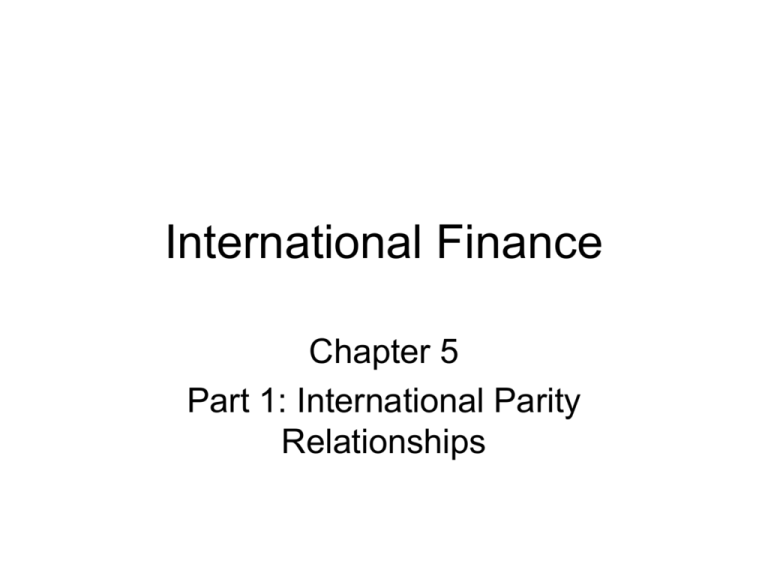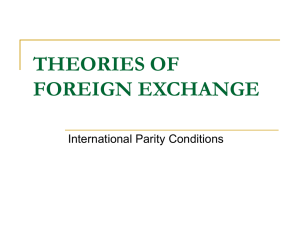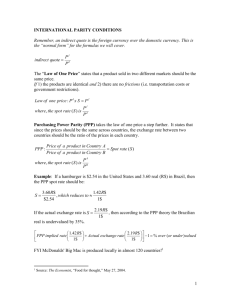International Finance - University of Colorado Boulder
advertisement

International Finance Chapter 5 Part 1: International Parity Relationships FORWARD RATES • Involves contracting today for the future purchase or sale of foreign exchange. – Forward rate is set today! • Forward rate can be: – Equal to spot (flat) – Worth more than spot (premium) – Worth less than spot (discount) EXAMPLES OF FORWARD RATES • Wednesday, June 4, 2004 • American Terms – U.K. (Pound) • 1 month forward $1.8343 $1.8289 • European Terms – Japan (yen) • 1 month forward 110.07 109.95 FORWARD DISCOUNTS AND PREMIUMS • Is the pound selling at a forward discount or forward premium? – U.K. (Pound) • 1 month forward $1.8343 $1.8289 • Answer: – Discount: 1 month forward is less than the spot by $.0054 FORWARD PREMIUMS AND DISCOUNTS • Is the Japanese yen selling at a forward premium or forward discount? – Japan (yen) • 1 month forward 110.07 109.95 • Answer: – Premium: Dollar is selling at a discount; with the 1 month forward less than the spot by .12 yen. – Convert to American terms (110.07 = $.009085; 109.95 = $.009095). Yen 1 month forward is worth $.000010 more than the spot. WHAT DETERMINES THE FORWARD RATE? • What does NOT determine forward rate: – Market’s expectation about where spot rate will be in the future. • What does determine forward rate: – Assuming no capital controls, in equilibrium the rate represents the difference in interest rates between the two currencies in question. INTEREST RATE PARITY • Interest rate parity theory provides a linkage (and explanation) between international money markets and (forward) foreign exchange markets. • The theory states that the difference in the national interest rates for securities of similar risk and maturity should be equal to, but opposite in sign to, the forward rate discount or premium for the foreign currency (except for transaction costs) EXAMPLE • Assume a US dollar-based investor has $1 million to invest for 90 days and can select from two investments: – Invest in the U.S. and earn 4.0% p.a. – Invest in Switzerland and earn 8.0% p.a. • Problem with Swiss franc investment: – Uncertainty about the future spot rate, or what if the franc depreciates against the dollar! • Solution for investor: – Cover the Swiss franc investment by selling the Swiss francs anticipated from the investment forward 90 days. – But what will the forward rate be? FORWARD RATE UNDER INTEREST RATE PARITY • In equilibrium, the forward rate must settle at a rate to offset the interest rate differential between the two currencies in question. • This is to insure that the two investments will yield similar returns. – To prevent covered interest arbitrage opportunities!!! COVERED INTEREST ARBITRIGE • Assume: – 90 day Interest rate in U.S. is 4% – 90 day Interest rate in Switzerland is 8% • Assume the spot rate and the 90 day forward rate are the same • A U.S. investor could invest in Switzerland, and cover (sell francs forward) and obtain a (foreign exchange) riskless return of 8% which is 400 basis points greater than investing in the U.S. • This is covered interest arbitrage! EQUILIBRIUM • In equilibrium the forward rate will price the currency to offset the interest rate differential. • In the previous example, the “correct” 90 day forward Swiss franc rate will be at a discount of 4% of its spot. • When the U.S. investor covers, the 8% Swiss return is reduced by the 4% discount, resulting in a covered return of 4%. VIEWING IRP i $ = 4.00 % per annum (1.00 % per 90 days) Start $1,000,000 S = SF 1.4800/$ End 1.01 $1,010,000 Dollar money market $1,010,000 90 days F90 = SF ?/$ Swiss franc money market SF 1,480,000 1.02 i SF = 8.00 % per annum (2.00 % per 90 days) SF 1,509,600 EQUILIBRIUM i $ = 4.00 % per annum (1.00 % per 90 days) Start $1,000,000 S = SF 1.4800/$ End 1.01 $1,010,000 Dollar money market $1,010,000 90 days F90 = SF 1.49465/$ Swiss franc money market SF 1,480,000 1.02 i SF = 8.00 % per annum (2.00 % per 90 days) SF 1,509,600 HOW IS THE FORWARD RATE CALCULATED? • The forward rate is calculated from three observable elements: – The (current) spot rate – The foreign currency deposit rate – The home (U.S.) currency deposit rate FORWARD RATE FORMULA FnFC/$ SFC/$ N FC 1 i x 360 x N $ 1 i x 360 • Where: Fn = forward rate (FC/$), n business days in the future. S = spot rate (FC/$) N = number of days in forward contract iFC = interest rate on foreign currency deposit i$ = interest rate on U.S. dollar deposit EXAMPLE • Assume: – Current Yen Spot rate = ¥120.0000 – 90 day dollar rate = 2.0% – 90 day yen rate = .5% • Calculate the 90-day yen forward rate FC/$ 90 F S FC/$ 90 FC 1 i x 360 x 90 $ 1 i x 360 SOLUTION FC 90 1 i x 360 FC/$ FC/$ F90 S x $ 90 1 i x 360 FC/$ 90 F S 120/$ x 1.00125 1.005 F90FC/$ 90 1 .005x 360 S120/$ x 90 1 .020 x 360 FC/$ 90 F 119.5522 SOLUTION TO SWISS FRANC EXAMPLE • Recall, the following information about the Swiss franc example: – Swiss franc spot rate of Sfr1.4800/$, – a 90-day Swiss franc deposit rate of 8.00% – a 90-day dollar deposit rate of 4.00%. FSfr/$ Sfr1.4800x 90 1 0.08 x 90 360 1 0.04 x 90 360 Sfr1.4800x 1.02 Sfr1.4947/$ 1.01 COVERED INTEREST ARBITRAGE • If the forward rate is not correct, the chance of covered interest arbitrage exists. • Generally, these situations will not last long • As the market takes advantage of them, equilibrium will be restored. EXAMPLE i $ = 4.00 % per annum (1.00 % per 90 days) Start $1,000,000 S = SF 1.4800/$ End 1.01 $1,010,000 Dollar money market $1,020,000* 90 days F90 = SF 1.4800/$ Swiss franc money market SF 1,480,000 1.02 SF 1,509,600 i SF = 8.00 % per annum (2.00 % per 90 days) •Assume the forward rate is 1.48. Then, the covered Swiss investment yields $1,020,000, $10,000 more than the U.S. investment. USING IRP TO FORECAST • While the forward rate under the assumption of the Interest Rate Parity model assumes: – The forward rate simply represents interest rate differentials – And NOT the market’s view of the future spot rate. • Some forecasters do use this model to forecast future spot rates. Forward Rates as an Unbiased Predictor • Some forecasters believe that the forward rate is an “unbiased” predictor of the future spot rate. • This is roughly equivalent to saying that the forward rate can act as a prediction of the future spot exchange rate, but – it will generally “miss” the actual future spot rate – and it will miss with equal probabilities (directions) and magnitudes (distances) which offset the errors of the individual forecasts! Forward Rates: Unbiased Predictor Exchange rate F2 S2 Error Error S1 F1 F3 Error S3 S4 Time t1 t2 t3 t4 The forward rate available today (Ft,t+1), time t, for delivery at future time t+1, is used as a “predictor” of the spot rate that will exist at that day in the future. Therefore, the forecast spot rate for time St2 is F1; the actual spot rate turns out to be S2. The vertical distance between the prediction and the actual spot rate is the forecast error. When the forward rate is termed an “unbiased predictor,” it means that the forward rate over or underestimates the future spot rate with relatively equal frequency and amount, therefore it misses the mark in a regular and orderly manner. Over time, the sum of the errors equals zero. Other Parity Models • Two other important parity models are: • Purchasing Power Parity – Exchange rate between two countries should be equal to the ratio of the two countries price level. – The change in the exchange rate will be equal to the difference in inflation. • International Fisher Effect – The change in the exchange rate will be equal to the difference in the nominal interest rate between two countries. LAW OF ONE PRICE • The Purchasing Power Parity model is based on the Law of One Price: – The Law of one price states that all else being equal (i.e., no transaction costs or other frictions) a product’s price should be the same in all markets (countries). – Why? The principle of competitive markets assumes that prices will equalize if costs of moving such goods does not exist. LAW OF ONE PRICE • When prices for a particular product are expressed in different currencies, the law of one price states that after adjusting for exchange rates, prices will be the same. • Example (U.S. and Japan): – The price of a product in US dollars (P$), multiplied by the spot exchange rate (S = yen per dollar), equals the price of the product in Japanese yen (P¥), or: P$ S = P¥ EXAMPLE • If a Big Mac costs $2.00 in the United States and if the current spot rate is ¥110, then the Law of One Price would suggest a price in Japan of: • $2.00 x ¥111 = ¥222.00 PPP EXCHANGE RATE • Conversely, if the prices for similar goods were known in local currencies, the appropriate (PPP) spot exchange rate (S) could be calculated from relative product prices, or • Spot PPP rate = Foreign Price/Home Price PPP Example: Sept 11, 2003 • • • • • Big Mac: Boulder, Colorado: $2.29 Big Mac: Osaka, Japan: ¥250 PPP Exchange Rate = Yen Price/Dollar Price PPP Exchange Rate = ¥250/$2.29 = ¥109.17 The PPP rate can be compared to the actual rate, and if: – – – – Actual > PPP = currency may be undervalued! Actual < PPP = currency may be overvalued! Rate on September 11, 2003 = 117.1240 Thus, this model suggested the yen was undervalued at that time (or dollar was overvalued). ABSOLUTE PPP • The “absolute” PPP measures the “correctness” of the current spot rate on the bases of similar goods in different countries. • A popular version of the absolute PPP technique is found in the Economist “Big Mac” index. Big Mac Index: Explanation From the Economist Magazine • “Burgernomics is based on the theory of purchasingpower parity, the notion that a dollar should buy the same amount in all countries. • Thus in the long run, the exchange rate between two countries should move towards the rate that equalizes the prices of an identical basket of goods and services in each country. • The Economist "basket" is a McDonald's Big Mac, which is produced in about 120 countries. • The Big Mac PPP is the exchange rate that would mean hamburgers cost the same in America as abroad. • Comparing actual exchange rates with PPPs indicates whether a currency is under- or overvalued.” Big Mac Index Web Site • The Economist Magazine publishes their Big Mac Index twice a year. – http://www.economist.com/markets/Bigmac/Index.cfm • Currently the index (May 27, 2004) suggests: – Swiss franc: PPP = 2.19; actual = 1.25 • World’s most overvalued currency! – Philippine peso: PPP = 23.8; actual = 55.8 • World’s most undervalued currency! OECD PPP MEASURES • A more comprehensive measure of a country’s PPP is provided by the OECD for 30 member countries. It can be found on the following website: • http://www.oecd.org/home/ • Or: • http://www.oecd.org/department/0,2688,en_264 9_34357_1_1_1_1_1,00.html RELATIVE PPP • The relative Purchasing Power Parity model is concerned with the “rate of change” in the exchange rate. • Model suggests that the percent change in the exchange rate should be equal to the difference in the rates of inflation between countries, or % change in FX rate = Home inflation rate – Foreign inflation rate. RELATIVE PPP EXAMPLE • Assume the following: – Annual rate of inflation in U.S. = 2.0% – Annual rate of inflation in U.K. = 3.0% • The British pound should depreciate 1% per year against the U.S. dollar. • If the current rate is $1.80, then – 1 year from now the rate should be: $1.7820 – 2 years from now the rate should be: $1.7642 – Etc…. TESTS OF THE PPP • The existing empirical tests of the PPP have proved disappointing. • Generally the results do not support the PPP. • However, PPP can still provide us with a “benchmark” test of whether a currency is overvalued or undervalued against other currencies. INTERNATIONAL FISHER EFFECT • The last major parity model is the International Fisher Effect. • Begins with the Fisher Effect: – A change in the expected rate of inflation will result in a direct and proportionate change in the market rate of interest. FISHER EFFECT • Market rate of interest is comprised of two components: – Real rate requirement • Relates to the real growth rate in the economy – Expected rate of inflation • Real rate requirement is assumed to be relatively stable • Thus, changes in market interest rates occur because of changes in expected inflation! FISHER EFFECT EXAMPLE • Assume the following: – real rate requirement is 3.0% – Expected rate of inflation is 1.0% • Under these conditions, the market interest rate would be 4% • If the expected rate of inflation increases to 2.0%, the market interest rate would rise to 5%. FISHER EFFECT DATA Country CPI Forecast 2004 2005 2 Year Gov’t Bond Rate Australia U.S. Switzerland Japan +2.2% +1.9% +0.7% -0.1% 5.27% 2.45% 1.13% 0.14% +2.5% +1.8% +0.4% nil Forecast: The Economist Poll, Date: May 29, 2004 FISHER EFFECT ASSUMPTIONS • Model assumes that the real rate requirement is the same across countries. • Thus market interest rate differences between counties is accounted for on the basis of differences in inflation expectations. • If the interest rate is 5% in the U.S. and 7% in the U.K. then: – The expected rate of inflation is 2% higher in the U.K. INTERNATIONAL FISHER EFFECT • Changes in exchange rates will be driven by differences in market interest rates between countries. • Because differences in interest rates capture differences in expected inflation. – High interest rate countries (due to high expected rates of inflation) will experience currency depreciation. – Low interest rate countries (due to low expected rates of inflation) will experience currency appreciation. INTERNATIONAL FISHER EFFECT EXAMPLE • Using interest rate data from Bloomberg’s web site (rates and bonds): – http://www.bloomberg.com/markets/index.html • 2 year U.S. Government rate 2.65% • 2 year Japanese Government rate: 0.14% • Higher U.S. rate is accounted for on the basis of higher expected U.S. inflation: • 2.65 – 0.14 = 2.51 EXCHANGE RATE CHANGE • Given the expected inflation differences, the yen will appreciate 2.51% per year. • Current spot rate 110. • Spot rate 1 year from now: 107.239 • Spot rate 2 years from now: 104.547 • Etc…








